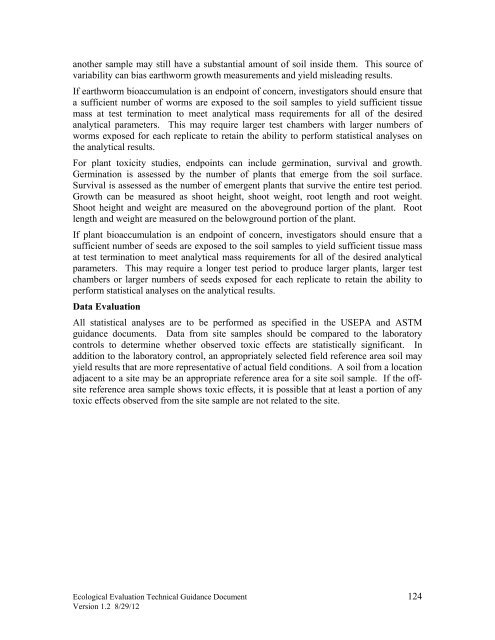Ecological Evaluation Technical Guidance - State of New Jersey
Ecological Evaluation Technical Guidance - State of New Jersey
Ecological Evaluation Technical Guidance - State of New Jersey
- No tags were found...
You also want an ePaper? Increase the reach of your titles
YUMPU automatically turns print PDFs into web optimized ePapers that Google loves.
another sample may still have a substantial amount <strong>of</strong> soil inside them. This source <strong>of</strong>variability can bias earthworm growth measurements and yield misleading results.If earthworm bioaccumulation is an endpoint <strong>of</strong> concern, investigators should ensure thata sufficient number <strong>of</strong> worms are exposed to the soil samples to yield sufficient tissuemass at test termination to meet analytical mass requirements for all <strong>of</strong> the desiredanalytical parameters. This may require larger test chambers with larger numbers <strong>of</strong>worms exposed for each replicate to retain the ability to perform statistical analyses onthe analytical results.For plant toxicity studies, endpoints can include germination, survival and growth.Germination is assessed by the number <strong>of</strong> plants that emerge from the soil surface.Survival is assessed as the number <strong>of</strong> emergent plants that survive the entire test period.Growth can be measured as shoot height, shoot weight, root length and root weight.Shoot height and weight are measured on the aboveground portion <strong>of</strong> the plant. Rootlength and weight are measured on the belowground portion <strong>of</strong> the plant.If plant bioaccumulation is an endpoint <strong>of</strong> concern, investigators should ensure that asufficient number <strong>of</strong> seeds are exposed to the soil samples to yield sufficient tissue massat test termination to meet analytical mass requirements for all <strong>of</strong> the desired analyticalparameters. This may require a longer test period to produce larger plants, larger testchambers or larger numbers <strong>of</strong> seeds exposed for each replicate to retain the ability toperform statistical analyses on the analytical results.Data <strong>Evaluation</strong>All statistical analyses are to be performed as specified in the USEPA and ASTMguidance documents. Data from site samples should be compared to the laboratorycontrols to determine whether observed toxic effects are statistically significant. Inaddition to the laboratory control, an appropriately selected field reference area soil mayyield results that are more representative <strong>of</strong> actual field conditions. A soil from a locationadjacent to a site may be an appropriate reference area for a site soil sample. If the <strong>of</strong>fsitereference area sample shows toxic effects, it is possible that at least a portion <strong>of</strong> anytoxic effects observed from the site sample are not related to the site.<strong>Ecological</strong> <strong>Evaluation</strong> <strong>Technical</strong> <strong>Guidance</strong> Document 124Version 1.2 8/29/12
















